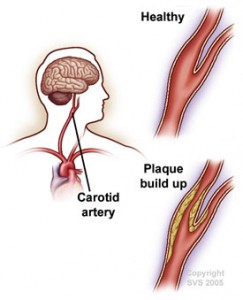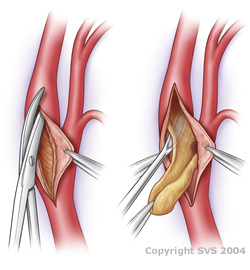Carotid Artery Disease
What is Carotid Artery Disease?
The carotid arteries are two large arteries that travel from the upper chest through the entire length of the neck and then enter the base of the skull to supply blood flow to the brain. They are the main source of oxygentated blood flow to the brain tissue.
Carotid artery disease is a condition in which these arteries become narrowed or blocked as the result of atherosclerosis (hardening of the arteries) with plaque build-up. The plaque is an abnormal substance containing fats, cholesterol, lipids, and calcium that builds up in the inner lining of the arteries. See: Atherosclerosis (hardening of the arteries) When the arteries become narrowed from the palque, the condition is called carotid stenosis. The disease can lead to medical complications to occur due to decreased blood flow or diminished blood perfusion to the brain.
Carotid artery disease occurs as a process of aging, with certain situations or conditions accelerating the process. The plaque may slowly block or narrow the carotid artery or cause a clot (thrombus) to form. Clots and plaque can both lead to strokes.
Stroke is the 4th leading cause of death in the United States. Some people who have a stroke recover most or all of their functions. Others die from the stroke itself or from complications. About half of those who have a stroke have long-term problems. Since many cases of stroke are related to treatable carotid artery disease, it is wise to undergo screening of your carotid arteries.
Risk factors for blockage or narrowing of the arteries include:
- High blood pressure
- Diabetes
- Heart disease
- High cholesterol
- Heavy tobacco use / smoking
- Kidney disease, especially when dialysis is needed
- Cocaine abuse
- Family history of stroke
- Increasing age
- Previous radiation therapy to the head, neck, or chest
Smoking is one of the highest risk factors. Smoking increases the risk of most types of stroke. People who smoke one pack a day have over two times the risk of stroke compared to nonsmokers.
Two uncommon conditions called Marfan syndrome and fibromuscular dysplasia (abnormal growth or development of the cells in the walls of carotid arteries) may also cause narrowing of the carotid arteries.
Symptoms of Carotid Artery Disease
You may or may not have any symptoms to warm you that carotid artery stenosis is occurring. In some patients it is discovered on a screening study such as ultrasound or CT scan, even though symptoms may not be present.
You may have neurological symptoms of a stroke or a transient ischemic attack (TIA). Some of these symptoms include:
- Weakness in one part of your body
- Blurred vision
- Confusion
- Loss of memory
- Problems with speech and language
- Loss of sensation on a portion of the body
- Difficulty swallowing
- Passing out or recurrent dizziness
Complications from Carotid Artery Disease
The major complication associated with carotid artery disease are:
Transient ischemic attack (TIA). This is an episode in which a person has stroke -like symptoms for less than 24 hours, usually less than 1-2 hours. A TIA is often considered a warning sign that a stroke may happen in the future if something is not done to prevent it.
Stroke. A stroke is the sudden loss or death of brain cells due to lack of oxygen to the brain tissue. A stroke can happen when a blood vessel in any part of the brain is blocked. The blood through the narrowed carotid artery may slow so much that a clot forms. A stroke may also occur if a small piece of a blood clot breaks off and travels to a smaller artery in the brain.
A TIA or stroke is a medical emergency. Go to the emergency room or call the local emergency number (such as 911) as soon as symptoms occur. When having a stroke, every second of delay can result in more brain injury.
Testing for Carotid Artery Disease
Your health care provider will perform a physical exam. The health care provider may hear an abnormal sound called a bruit when using a stethoscope to listen to the blood flow in your neck.
A physical exam may also reveal clots in the blood vessels of the eye. If you have had a stroke or TIA, a neurological exam will reveal other problems.
The following tests may be done:
- Blood tests to check cholesterol and triglycerides
- Blood sugar (glucose) test
- Ultrasound of the carotid arteries (carotid duplex or doppler study) to see how well blood is flowing through the carotid arteries
These additional imaging tests may be used to further examine the blood vessels in the neck and brain:
- Magnetic resonance angiography (MRA)
- Computerized tomographic angiography (CTA)
- Carotid or cerebral angiography
TREATMENT OF CAROTID ARTERY DISEASE
Depending on the severity of the narrowing or stenosis, you may require a stent procedure or a surgery called carotid endarterectomy. If the blockage is not considered critical, then it may be managed conservatively with medical management and close surveillance.
Non-surgical treatment options include:
- Checking your carotid artery with ultrasound testing every year
- Medicine and diet to lower your cholesterol and control your blood pressure
- Blood-thinning medicines to lower your risk of stroke. Some of these medicines are aspirin, clopidogrel (Plavix), Aggrenox, Effient, and warfarin (Coumadin).
Interventional treatment options include:

Carotid stenting involves initially placing a small catheter into the femoral artery in the groin through a small puncture in the skin. The catheter is then guided into the neck under x-ray guidance. X-ray dye is injected through the catheter to take pictures of the artery (a procedure called an angiogram). Then a stent (a collapsed piece of metal rolled into a small straw-shaped tube) is inserted through the catheteter under x-ray guidance and then deployed into the artery at the site of the plaque narrowing, pushing the plaque to the side of the artery and returning the blood flow to a normal level.
Carotid surgery, called carotid endarterectomy, is an open surgical procedure that is used to remove the buildup of plaque from your carotid arteries. The purpose of carotid artery endarterctomy is to help prevent new strokes from occurring in persons with signficant blockages in their neck arteries. This artery procedure involves making an incision on the front of the neck to directly remove the plaque. The procedure is most typically performed in an operating room under general anesthesia. Patients are usually kept in the hospital overnight to observe them after the surgery, but they are usually released the next day.
STOKE PREVENTION
The following can help prevent a stroke:
- Avoid fatty foods. Follow a healthy, low-fat diet.
- Do not drink more than 1 to 2 alcoholic drinks a day.
- Exercise regularly: 30 minutes a day if you are not overweight; 60 – 90 minutes a day if you are overweight.
- Quit smoking.
Get your blood pressure checked every 1 – 2 years, especially if high blood pressure runs in your family. If you have high blood pressure, heart disease, or have had stroke, you need to have it checked more often. Ask your doctor.
Everyone should keep their blood pressure below 120-130/80 mmHg. If you have diabetes or have had a stroke, you may need to strive for a lower blood pressure. Ask your doctor what it should be.
Adults should have their cholesterol and triglycerides checked every 5 years and treated, if needed. If you have ever been treated for high cholesterol or high lipids or have significant risk factors, you may need these checked more often.
If you have diabetes, heart disease, or hardening of the arteries somewhere else in your body, your LDL “bad” cholesterol should be lower than 70 mg/dL.
Speak with your doctor to determine if you would benefit from taking a daily aspirin or other anti-platelet medication to minimize your risk of stroke.
Follow your doctor’s treatment recommendations if you have high blood pressure, diabetes, high cholesterol, and heart disease.
Get a Carotid Ultrasound Screening
Carotid duplex (also known as carotid ultrasound) is a diagnostic procedure that uses an ultrasound to detect blood flow problems in the carotid arteries, which are located in the neck and send blood to the brain. Blood clots and narrowed arteries are among the conditions that can be diagnosed through a carotid duplex. This test is commonly performed on patients who recently had a stroke or transient ischemic attacks (TIA).
Carotid duplex is usually performed in the doctors office, with the patient lying down on their back. A gel is applied to the skin, and a handheld machine known as a transducer is lightly run across the neck, along the carotid arteries. The transducer sends sound waves through the neck; these sound waves then bounce across the blood vessels, forming images of their arrangement. Due to its noninvasive nature, preparations are not necessary for a carotid duplex. In addition, there are no risks associated with this test. No radiation is involved.










